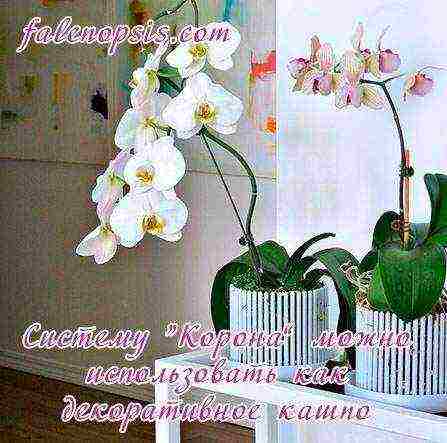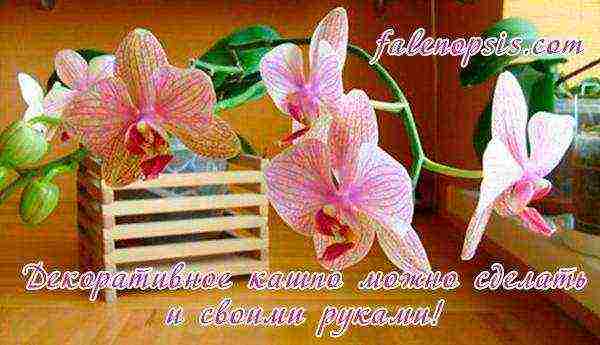Content
I want to share my thoughts. Everyone knows that phalaenopsis - one of the most unpretentious orchids - survive well in an apartment, bloom, in general, they adapt. But - it is pretty dry at home, and all orchs have roots that are above the substrate (and partially in the substrate), as a rule, dry out and do not look very beautiful. One of the phalaenopsis bloomed for me and I decided to put it in the back of the room on a coffee table during flowering to decorate the interior. To hide the ugly plastic pot, I shoved it into a ceramic vase so that the pot did not reach the bottom of the vase. Thus, the water with which I watered the flower flowed to the bottom of the vase, then evaporated, and the roots, thus. received additional moisture, but did not get wet. When about a month later I took the pot out of the vase, there was not a single dried root in it! That is, it turns out that Orha liked this content. Therefore, I'm going to buy beautiful pots and shove all the orchids in them. Tell me, did I come up with the right idea? And another question: in the flowerpot, the roots of the faliks will not receive sunlight - is it very scary, or is it worried?

I was presented with two orchids, I want to transplant them into beautiful plastic flowerpots, but many dissuade me, advise me to choose transparent containers. Dear growers, tell me, should the pot really be transparent? What is the reason? K.R., Orenburg
Growing orchids in transparent pots is optional, but desirable. The fact is that the transparent walls of the flowerpot allow the grower to objectively assess the well-being of the flower. It often happens that, due to improper watering, the root system is affected by rot, but this cannot be said about the above-ground parts of the plant. The orchid may even bloom at this time.
Through the walls of transparent plastic, negative processes can be noticed in time and the necessary measures can be taken to save the diseased plant.
Pay attention to the color of the root system. If you notice that the roots have become dark green, almost black, then rotting has begun. It is urgent to get the flower out of the pot, cut off the affected roots, treat the cut points with potassium permanganate and crushed coal.

Healthy roots are either bright green or silvery green. The fact is that the top layer of orchids is covered with velamen. It consists of dead cells that, when viewed under a microscope, resemble the porous surface of a sponge. Capillary absorption of moisture and nutrients occurs through this layer. When the supply of liquid is used up, the voids of velamen are filled with air, and the roots acquire a light silvery hue. Bright green color - at the roots saturated with moisture. They turn green because the moisture-filled velamen shines through green chloroplasts.
It should be noted that the root system of the orchid does not need to be rooted in any substrate. In nature, these beautifully blooming epiphytes grow directly on trees, rocks, or at the very surface of the earth. The roots collect moisture and nutrients directly from the air.
Placing orchids in a container is a tribute to the tradition of growing indoor flowers. Therefore, the plant feels most comfortable in a suspended state, when the roots hang freely, or are laid in containers in the form of a basket. However, you can plant a plant in an ordinary pot, just do not abuse it with watering and provide good drainage to the roots.But it is not recommended to lodge flowers in ceramic products. The fact is that swollen roots can stick to the damp wall of a clay pot, and when they dry out, they cannot return to their previous position without damage.
Phalaenopsis orchids are called "daughters of the air" for a reason, their root system participates in photosynthesis and needs oxygen, like all living things. Growing phalaenopsis in a glass pot belongs to extreme methods, but this method still has a right to exist. Consider what kind of planting containers orchids love, and how they behave in closed systems.
What is the best way to grow phalaenopsis
To understand which pots are suitable for phalaenopsis orchids, you need to understand the characteristics of the root system of these plants. The roots of epiphytes are actively involved in the process of photosynthesis and do not tolerate excessive moisture. In addition, phalaenopsis need good aeration of the substrate and the roots themselves inside the container. Therefore, these hybrids are grown, transported and sold in transparent plastic containers equipped with many holes in the bottom.

The most popular question from novice bird lovers is how to choose a container for planting or transplanting a plant. For home cultivation of phalaenopsis, the pot must meet all certain requirements, namely:
- be made of soft plastic;
- have holes at the bottom for a good outflow of moisture;
- the volume should correspond to the volume of the root system.
Most novice florists find it difficult to choose a pot for an orchid, because the assortment is wide enough, there are a lot of opinions and reviews, and given that phalaenopsis adapt to new conditions for a long time, I still want to guess with the purchase.
The Corona system - good or bad?
In addition to the aforementioned plastic pots, there are also glass constructions on sale designed specifically for this type. They are called "crown" and are advertised as the most versatile and the best pots for the Phalaenopsis orchid, but they cause a lot of controversy among experienced gardeners.
It is quite difficult to maintain the moisture content of the substrate in them, especially in the winter season, when in most apartments the air is dry and warm. Accordingly, the root system dries up very much, and with the next watering, the roots begin to rot.
Another unpleasant moment associated with this type of pots is trauma to the roots. Through the wide openings, the growing roots crawl out, and when transplanting, it is quite difficult not to break them.

But this system can be perfectly used as a decorative pots for orchids, in which you can place phalaenopsis in the most ordinary plastic pot. The light will perfectly pass through the openings of the "crown", while the pot itself will not be visible, and the structure will fit well into the interior.
Opaque containers
Also in the assortment of containers for orchids there are colored containers. This suggests whether it is possible to plant a phalaenopsis orchid in an opaque pot? Such a "residence" is better suited for the dendrobium or cymbidium varieties, their root system does not need lighting. But there is also a fairly wide range of colored translucent glass and plastic pots - they will provide lighting for the phalaenopsis roots and will look beautiful at the same time.

If you are not so long ago fond of growing orchids and are not sure what kind of pot your blooming pet needs, opt for a regular plastic pot. At low temperatures and high humidity, you can always make holes in them, and the root system will be in plain sight.
Quite often, an orchid pot is confused with a plastic or glass planter. These containers are not designed for orchids!
This method of growing epiphytes is called a "closed system" or ZS.It requires certain conditions, as well as a number of skills from the owner of the orchid.
Phalaenopsis in glass
As we already said, phalaenopsis pots are not suitable as a permanent residence. Despite the nondescript appearance of ordinary plastic pots, they are the best solution for both beginners and experienced flower growers. However, it is worth noting that phalaenopsis over the years of breeding have learned to adapt to various conditions, which makes it possible to grow them in a glass orchid planter or in a beautiful vase.

Things to consider when transplanting into a glass pot:
- Moisture will accumulate in such a pot, so you will need to get used to properly watering the plant.
- It is worth remembering that an orchid in a glass vase needs good drainage, therefore, it is necessary to pour expanded clay of a medium fraction on the bottom of the vase, and select a larger bark.
- It is necessary to adapt the plant to such a pot gradually, watering should be done moderately along the edge of the container.
- This method is not suitable for beginners!
Advice! When transplanting the phalaenopsis into a closed glass system, place a piece of Styrofoam at the base of the neck. This will protect the plant from waterlogging and decay of the growing point.
When deciding to grow epiphytes in closed systems, you should also take into account your conditions in an apartment or house. So, for example, mini-phalaenopsis need more moisture than midi and standard plants, but they do not tolerate cold well. If the room is humid, cool, and the mini lives in a glass pot, there is a very high probability of root rot.
Ceramics
Ceramic containers for phalaenopsis orchids are no less popular today. They are available with or without fluid drain holes. Such pots are good because ceramics keep the temperature well, preventing hypothermia of the root system and its further decay.

But in fairness, it should be noted that over time, the roots stick to the walls of such pots, which greatly injures them during transplantation. Therefore, the best solution would be to place flowers planted in plastic containers in ceramic pots.
Growing orchids in homemade pots
Orchid lovers are quite inventive people and instead of boring plastic pots they often use homemade containers. As a rule, these are plastic containers for yogurt, mayonnaise and other food products. With the help of sharp scissors or a drill, holes are drilled in them and the phalaenopsis pot is ready!

Another material used for planting epiphytes is pine baskets. Although they are more suitable for vandam and coriantes, phalaenopsis can also be planted in such pots. They look quite decorative, and instead of a substrate, you can use a pine block and sphagnum moss.
To make such a container yourself, you need to make a little effort:
- The same pieces are cut out of pine, polished and fastened in any way possible.
- A pine block with a plant fixed on it is laid at the bottom of the basket.
It is important to remember that this method of growing phalaenopsis requires frequent moisture and plant adaptation. It is not recommended for inexperienced growers to use it.
As a result
In order for the orchid to be healthy and delight its owners with lush and long flowering, it is necessary to create optimal conditions for it:
- Phalaenopsis love the combination of heat and high humidity, but getting only one thing - they can get sick.
- The root system is involved in photosynthesis, so plants need transparent pots for good growth.
- There must be good air circulation inside the substrate.
- Growing in glass, ceramics and other unconventional containers is only suitable for experienced florists.
We hope that based on our recommendations, you will be able to choose the best pot for your pet.
What do your orchids grow in?


